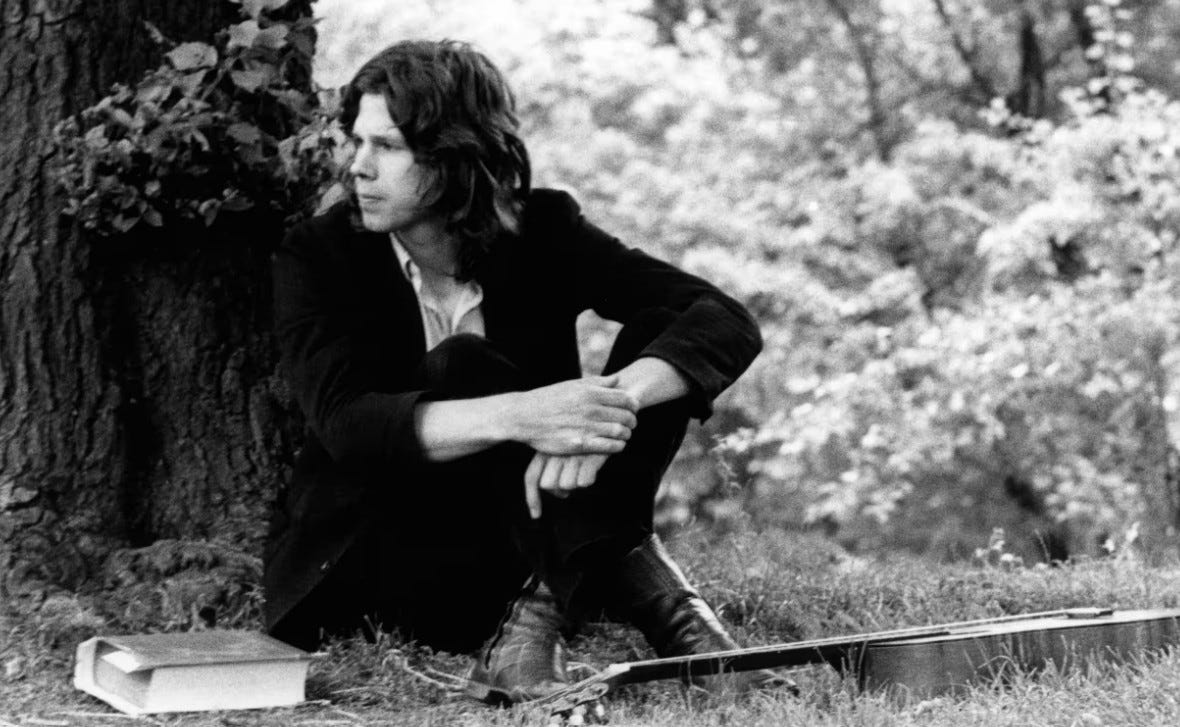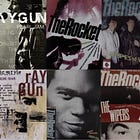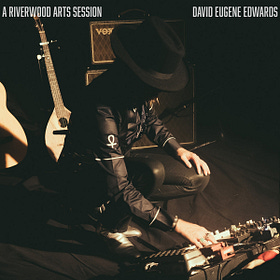Nick Drake : Inspiration for Chris Cornell and Mark Lanegan
''If you listen to his records and the way he plays guitar, he was incredibly forceful and aggressive on it...For me as a guitar player, he’s someone I would think of as a guitar god'' - Chris Cornell
What does English folk musician Nick Drake have in common with Seattle’s grunge music? Is it his dark acoustic music? Tragic life story? His persona- the mysterious, solitary and depressive songwriter who pours his heart into his music? Is it all the above? Is Nick Drake one of the biggest influences on grunge music? Well he is for Chris Cornell and Mark Lanegan.
Nick Drake has been credited as an influence by Robert Smith (The Cure), Peter Buck (R.E.M), Kate Bush, The Black Crowes and many more. He released three albums Five Leaves Left (1969), Bryter Layter (1971) and Pink Moon (1972). He is an incredible and underrated songwriter and guitarist. Notably, he was 20 years of age and a student at University of Cambridge when he got signed to prestigious Island Records. He suffered depression and was reluctant to perform live and completely stopped live performances after his 3rd album. He did not receive any acclaim or wide popularity during his lifetime, only gradually getting critical acclaim after his death. Drake passed away at the age of 26 due to an an overdose of antidepressants.
Steve Sutherland was Melody Maker's Deputy Editor in the 1980s and Editor of NME from 1992-2000. In 2005 he wrote an interesting article comparing Nirvana’s frontman Kurt Cobain to Nick Drake. He makes an interesting point in which he argues that we as listeners love mysticism and premature death when it comes to rock stars. It is the sole reason why Nick Drake’s music got popular after his mysterious death. This is because if ‘‘Nick Drake was alive today, bald, fat and shuffling around his garden in a cardigan like Pink Floyd casualty’’ his music would not have been dug up:
‘‘But truth is, we secretly love it when rock stars die. And the more mysterious and premature the death, the better. A good rock death affords us a rare glimpse of eternity as we eagerly recast the artist’s work and life into one body, pregnant with the inevitable symptoms of tragedy. So it was with Nick Drake. Before he overdosed on anti-depressants in 1974, the world largely ignored him – just another mewling singer-songwriter among thousands. His dark nights of the soul were nothing to do with the weight of fame, like that piled upon poor Kurt until he blew his face in. Quite the opposite. Today’s thriving Nick Drake industry is built solely upon the irony that not being wealthy and famous in his lifetime was a contributing factor in the depression that led to his death.
But once he’d gone, the autopsy on his neglected career revealed – oh joy! – that he had died gorgeous and young, leaving a meagre clutch of deliciously moody photos and a mere three albums that appeared to unravel a tale of sheer melancholic perfection. The lush, autumnally exuberant ‘Five Leaves Left’ , followed by the more commercially-focused failure ‘Bryter Layter’ and then the stark majesty of 1972’s ‘Pink Moon’ – tapes of which were left without ceremony on the reception desk at Island’s offices – seemed to unveil a man and his talent in the gradual process of ceasing to exist.
There is a newly discovered track, ‘Tow The Line’, which was found lurking like the Holy Grail at the end of a tape of old demos. The track is raw and sounds as desperate as the other songs on the same tape, including the harrowing ‘Black Eyed Dog’. They might have been meant for a new Nick Drake album. They might not. Maybe they would have been chucked away – ‘Tow The Line’ is nowhere near his finest work – or perhaps polished up with big brass bands. We don’t know. All we can be sure of is that, like Kurt Cobain, this track was not meant for release like this and to herald its rawness as symbolic of Drake’s decline is just a wilful misreading of the facts. In fact, if Nick Drake was alive today, bald, fat and shuffling around his garden in a cardigan like Pink Floyd casualty, Syd Barrett, it’s certain it would never have been dug up in the first place. It’s taken a death to give this stuff life – not a trade-off we should encourage.’’(Sutherland, 2005)
This is an interesting perspective and makes one question this: If Kurt Cobain was alive today, would Nirvana still have such a great influence as it still holds to this day? Has it taken a death to give this music eternal power and influence ?
Chris Cornell : Poncier EP and Nick Drake as a ‘‘Guitar God’’
When it comes to Soundgarden’s frontman Chris Cornell, Nick Drake can be credited as one of the influences on his acoustic songs.
The Poncier Tapes firstly showcased a side of Cornell that was not seen before. Instead of heavy, distortion, the songs on the tape are acoustic and melancholic musical revelations. For the film ‘‘Singles’’ (1992), director Cameron Crowe planned to have Cornell play the main character Cliff Poncier. However, at the end it was given to Matt Dillon. In the film Jeff Ament alongside other Pearl Jam members play the parts of band members of Citizen Dick (fronted by Poncier). Ament and Cornell put together Poncier EP, which Cornell later recorded. Resulting in 5 songs: ‘‘Seasons’’, ‘‘Nowhere But You’’, ‘‘Flutter Girl’’, ‘‘Spoon man’’ and ‘‘Missing’’. ‘‘Spoon Man’’ would become one of Soundgarden’s biggest hits.
Like I said, Nick Drake is an inspiration behind the melancholic, folk-acoustic pieces, like ‘‘Nowhere But You’’(1992) and ‘‘Seasons’’(1992). This can also be said about his solo album Euphoria Morning (1999) which features ‘‘Flutter Girl’’(1992) and more acoustic driven songs like ‘‘Can’t Change Me’’ (1999). Cornell explains that:
‘‘When we were at our most aggressive period in Soundgarden I just wanted to hear something that wasn’t guitar feedback, I started listening to anything that I could find that was super stripped-down. I bought the Nick Drake boxed set, and my favourite album was Pink Moon, where it's really just him and a guitar.’’(Reiff, 2020, p.147)
He considers Drake as a guitar God and highlights that his music expressed an underlying angry quality. This can be heard on ‘‘Seasons’’ when Cornell alternates between soft and intense vocals. With angry desperation he sings ‘‘Well I want to fly above the storm, But you can't grow feathers in the rain, And the naked floor is cold as hell’’. Closing the song with soft, airy and light vocals.
Likewise, influence of Drake's forceful and aggressive guitar style can be heard in the guitar tuning. Drake used different open and dropped tunings, and made one guitar sound as if 3 were playing. For example, ‘‘Road’’ (1972) and ‘‘Place To Be’’ (1972). This is the same with ‘‘Seasons’’ which uses FFCCCF tunning, not typical or standard in the musical world. This tuning brings depth and truly gives the impression that more than one guitar is performing. Likewise, the song has parts in which the guitar is being played more aggressively like in the bridge part. Cornell explains that:
‘‘Everyone talks about the introspective, shy, quiet, tragic Nick Drake, but if you listen to his records and the way he plays guitar, he was incredibly forceful and aggressive on it. He’d just pull on the strings. There was some underlying thing going on that was almost angry. I don’t know if a lot of people set that, but I got it and it was kind of a surprise. For me as a guitar player, he’s someone I would think of as a guitar God. ‘’(Sarig, 1998,p.112)
Mark Lanegan: ‘‘I find Nick Drake, Joy Division and a lot of old blues songs to be uplifting’’
The melancholic, dark acoustic/folk sound dominates throughout Mark Lanegan’s solo records like The Winding Sheet which I discussed in a previous post. This sound and atmosphere is the same as in ‘‘Seasons’’ or even Nirvana’s legendary MTV Unplugged performance.
One side of grunge is all about distortion, however the other side of grunge is concerned with creating a acoustic, mystical, eerie and sombre musical universe. And just like the case with Chris Cornell, Nick Drake holds an inspiration for Mark Lanegan. Even KEXP’s review of The Winding Sheet (1990) by Levi Fuller concludes that Lanegan ‘‘has more in common w/Nick Drake or Thin White Rope than his work w/The Screaming Trees’’ (Fuller, 2014). Mark Lanegan was said to have recorded Drake’s ‘‘Clothes Of Sand’’ around the 2000s and at one point was involved in a Nick Drake tribute album. Lanegan himself said that Nick Drake’s music saved his life and told his story back to him:
‘‘Joy Division, Nick Drake, Son House, The 13th Floor Elevators, The Gun Club – all the music that meant the most to me, the music that saved my life, was the music that told my own story back to me." (Sharma, 2022)
‘‘Not that I naturally feel bad to start with, but I find Nick Drake, Joy Division and a lot of old blues songs to be uplifting. They make me feel good. So I guess one man's misery is another man's Disneyland.’’ (Hersey, 2016)
The Winding Sheet sound wise resembles Nick Drake’s style in Pink Moon (1972). For example ‘‘Harvest Breed’’ (1972) and ‘‘From The Morning’’(1972). Particularly, as both songs use alternative, open tunings, which are much darker in sound. The strumming pattern and rhythm of ‘‘From The Morning’’ is also reminiscent of Chris Cornell’s ‘‘The Keeper’’(2011).
Lyrically, Nick Drake expresses themes which can be found in grunge music. Particularly, melancholy, criticism, disgust and even hate of oneself. For example, the song ‘‘Parasite’’ (1972) expresses :
‘‘Take a look, you may see me on the ground
For I am the parasite of this town
And take a look, you may see me in the dirt
For I am the parasite who hangs from your skirt’’
This song was also covered by Mark Lanegan and Dana Kletter.
There is a separation between himself and others, in a self degradation manner. There is a sense of defeatism and helplessness, which can also be found in Cornell’s ‘‘Seasons’’ when he sings ‘‘I am lost behind, the words I never find, and I’m left behind, as the seasons roll on by’’.
The remark ‘‘You may see me in dirt’’ is constantly one way or another referenced in grunge music. Dirt (1992) is the tittle of Alice In Chains most famous album. And of course the whole grunge aesthetic is concerned with an aesthetic that is anti-luxury, anti-establishment, pro- working class and pro-thrifting culture. Like I discussed in a previous post about the grunge aesthetic and grunge graphic design, grunge uses dirty, subdued and dull colours to convey solitary, pessimism, and nihilism.
Also grunge songs reference the word. For example, Alice in Chains ‘‘Dirt’’ (1992) : ‘‘You have the talent to make me feel like dirt, And you, you use your talent to dig me under and cover me with dirt’’; Pearl Jam ‘‘Down’’ (2002) : ‘‘If hope could grow from dirt like me, It can be done’’, Soundgarden ‘‘Mailman’’ (1992) : ‘‘Hello, don't you know me? I'm the dirt beneath your feet, the most important fool you forgot to see’’; Nirvana ‘‘Very Ape’’ (1993) : ‘‘Out of the ground into the sky, out of the sky, into the dirt’’; Mudhoney ‘‘Mudride’’ (1988): ‘‘I got a mouth full of dirt’’, ‘‘Take you down to the dirt, drag you through the mud’’. Thus, grunge songwriters have the same attitude of oneself as Nick Drake. He is a key inspiration for grunge musicians and also how they portrayed themselves- troubled songwriter’s who poured their heart into music and lived for it. A characterisation which perfectly fits Cobain, Cornell, Staley and Lanegan.
Reading daily exercises the brain, improves sleep and reduces stress, so why not read some more?! Check this out:
David Eugene Edwards
David Eugene Edwards, the unique musician known for his unique blend of Americana, folk, and alternative rock, has always been unapologetically himself. I have never really heard anything like it. His music is heavy and dark on a completely different level. I talked about him a few months back in a post about The Den…









Very informative to see the correlation between Nick, Mark and Chris. Three very different but interesting artists. I appreciate all of them. Such a shame they all left way too soon. But we are left with a treasure trove of their material to keep close to our hearts.
Thank you for this wonderful reading of very missed musicians. Today I lit a candle for them while I played their music. The flame will be extinguished but their memories and music will live on forever.
So well put together, such a strong article! 💪🏻💪🏻💪🏻